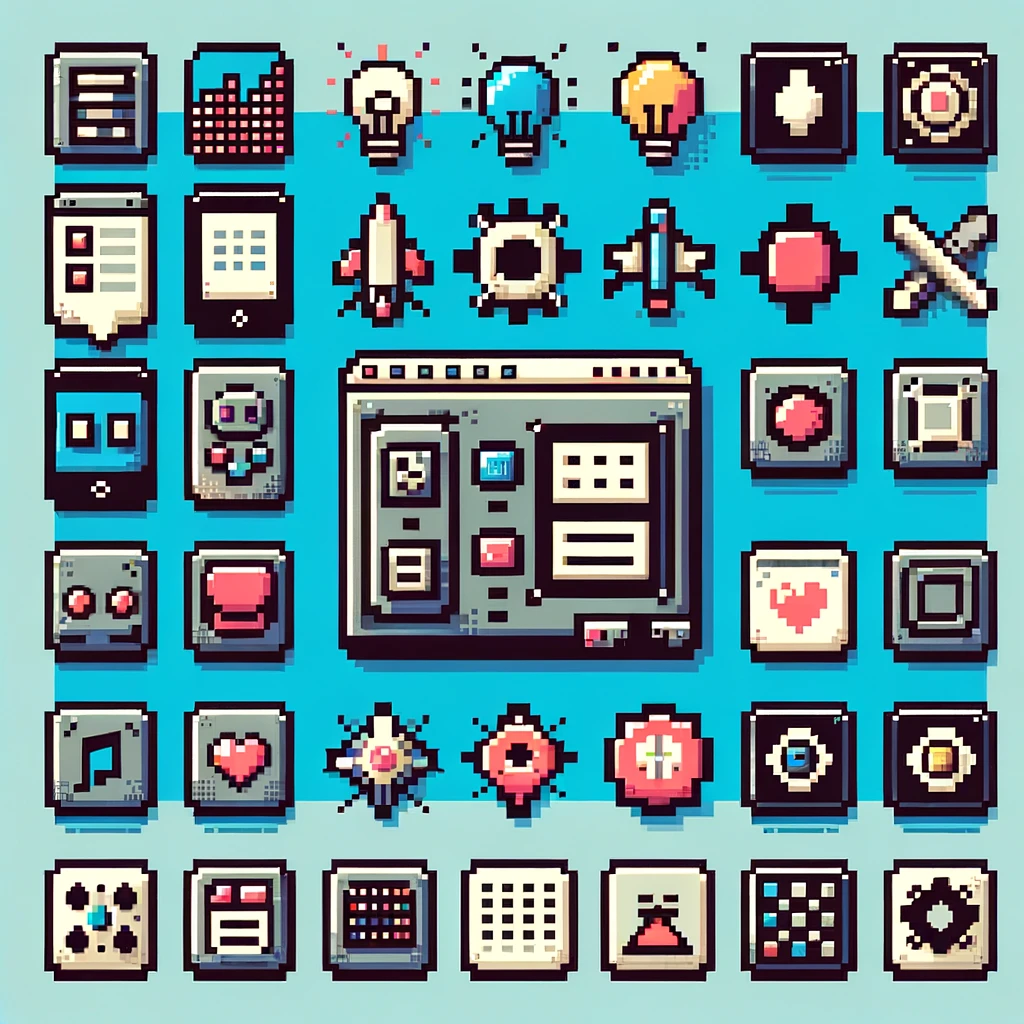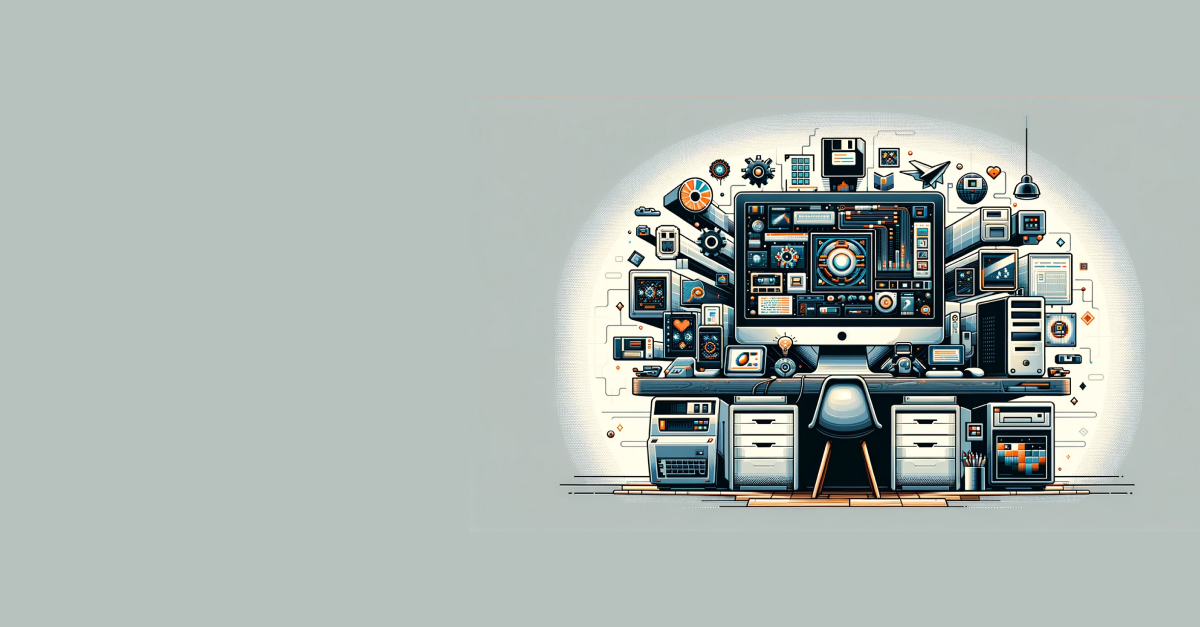In a world dominated by high-definition graphics and seamless user interfaces, there’s a growing fascination with the simplicity and nostalgia of retro computing.
I invite you to talk about the unexpected resurgence of 8-bit aesthetics in modern software development, not merely as a nostalgic nod but as a legitimate design philosophy influencing contemporary app development.
Historical Context
The dawn of the digital age in the late 20th century was marked by significant limitations in computing hardware, most notably in graphics capabilities. Early computers, constrained by memory and processing power, could only display a limited range of colors and resolutions. This era, often referred to as the 8-bit era, was defined by computers and gaming consoles that operated on 8-bit microprocessors. These devices included iconic machines like the Commodore 64, the Nintendo Entertainment System (NES), and the ZX Spectrum, among others.
The term “8-bit” refers to the computing power of the processors within these machines, capable of handling 8 bits of data at a time. This technical limitation directly influenced the aesthetic of the software they ran, including games, applications, and operating systems. Developers of the time were forced to work within strict constraints, leading to the creation of pixel art graphics and chiptune music. These creations were characterized by their blocky, pixelated visuals and simple, catchy audio. The color palettes were limited, often to a few dozen colors, requiring artists and developers to be exceptionally creative with their designs to make them visually appealing and distinct.
Despite these limitations, or perhaps because of them, the 8-bit era was a hotbed of creativity and innovation. Developers pushed the boundaries of what was possible, creating iconic games and software that remain beloved to this day. Games like “Super Mario Bros.,” “The Legend of Zelda,” and “Pac-Man” were not only marvels of design and gameplay within their technical constraints but also set foundational principles for game design that are still studied and revered.
The influence of 8-bit graphics and the era’s aesthetic did not wane as technology advanced. Instead, it became a cultural and artistic touchstone, representing a simpler time in digital creativity where the focus was on innovative design within constraints. This period highlighted the importance of creativity and problem-solving, principles that are increasingly relevant in today’s digital landscape, where the sheer possibility can sometimes lead to complexity rather than clarity.
The resurgence of retro computing and 8-bit aesthetics in modern design is more than just nostalgia; it’s an acknowledgment of the creativity and ingenuity of early digital pioneers. It serves as a reminder that simplicity and constraint can often lead to the most memorable and impactful creations. This historical context sets the stage for exploring how the principles of 8-bit design are being reimagined and integrated into contemporary software development, offering lessons in creativity, efficiency, and the enduring appeal of simplicity.
The 8-bit Aesthetic Revival
In recent years, the digital world has witnessed a remarkable resurgence of 8-bit aesthetics, a trend that transcends mere nostalgia to embody a broader cultural appreciation for simplicity and creativity in design. This revival is not confined to the realms of gaming and entertainment; it has permeated various facets of software development, influencing the design of apps, websites, and even marketing materials. This section delves into the reasons behind this aesthetic revival, its manifestations, and the underlying principles that make 8-bit designs enduringly appealing.
Why the Revival?
The resurgence of 8-bit aesthetics can be attributed to several factors, chief among them being a collective yearning for simpler times. As technology advances at a breakneck pace, there’s a growing segment of both creators and consumers who find solace and joy in the straightforward, unambiguous expressions of 8-bit art. For many, these graphics evoke memories of childhood and a time when digital experiences were new and wondrous.
Additionally, the 8-bit revival is a reaction against the sometimes overwhelming complexity of modern digital interfaces. In a sea of high-definition images and fluid animations, the stark, grid-based simplicity of pixel art stands out. It offers a unique visual and emotional clarity that resonates with people seeking a break from the visually complex world.
Manifestations in Modern Design
The 8-bit aesthetic has found its way into various digital products and experiences. Mobile games that mimic the look and feel of classic arcade games have found a substantial audience, proving that the appeal of pixel art and chiptune music is not limited by age or gaming history. Beyond gaming, app developers have adopted 8-bit inspired icons and interfaces to imbue their products with a retro feel that captures users’ attention and distinguishes their offerings in crowded app stores.
Websites and digital marketing campaigns also increasingly leverage 8-bit graphics to stand out and engage audiences. These designs often combine the nostalgia factor with modern design principles, creating a fusion that appeals to a broad demographic spectrum.
The Principles Behind the Pixels
The enduring appeal of 8-bit aesthetics in modern design is not just about looking back; it’s also about the principles that this style embodies. These include:
- Simplicity. In an age where digital experiences can be overwhelmingly complex, the straightforward nature of 8-bit art is refreshing. It forces designers to distill concepts to their essence, conveying ideas and emotions with minimal visual elements.
- Creativity Within Constraints. The technical limitations of 8-bit systems demanded ingenious solutions from developers and artists. This ethos inspires modern designers to think more creatively, even when current technology offers vast possibilities.
- Emotional Connection. For many, 8-bit graphics evoke nostalgia, creating an immediate emotional connection. But even for those without these nostalgic ties, the charm and distinctiveness of the style can generate a strong emotional response.
- Clarity and Usability. The grid-based nature of pixel art lends itself to clear, easily understandable interfaces. In an era where user experience is paramount, the clarity of 8-bit inspired designs can enhance usability.
The 8-bit aesthetic revival in modern software development is more than a mere trend; it represents a deeper appreciation for the art of simplicity and the power of constraint-based creativity. As we continue to navigate an ever-more complex digital landscape, the principles underpinning this revival offer valuable lessons for creating memorable, engaging, and effective digital experiences.
Design Principles Derived from 8-bit Aesthetics

The resurgence of 8-bit aesthetics in modern design not only pays homage to the early days of computing but also brings to the forefront timeless design principles. These principles, distilled from the necessity of working within the severe limitations of early computing hardware, have proven their value and adaptability in the context of contemporary software development. Let’s explore these fundamental design principles and how they can be applied today.
1. Economy of Visual Elements
The limited graphical capabilities of 8-bit systems meant that every pixel mattered. Designers had to convey character, setting, and action with a minimal visual vocabulary. This economy of design teaches modern creators the value of simplicity and the power of using fewer elements to convey a message or evoke an emotion effectively.
Application Today: In UI/UX design, this principle translates to minimalistic interfaces that prioritize essential features, reducing cognitive load and enhancing user engagement.
2. Constraint-Based Creativity
Constraints often fuel creativity, a fact epitomized by 8-bit designers who worked miracles within the tight bounds of their hardware. This necessity to innovate within constraints led to some of the most iconic and enduring designs in digital media.
Application Today: Modern software developers can embrace constraint-based creativity by setting intentional limits, such as minimal use of color or streamlined navigation paths, to foster innovative solutions.
3. Clarity and Readability
Given the low resolution of 8-bit graphics, ensuring clarity and readability was paramount. Icons, characters, and environments were designed to be as legible as possible, often relying on bold colors and simple shapes to communicate effectively.
Application Today: Clarity remains a cornerstone of good design, especially in information-dense applications. Emphasizing legibility and straightforwardness can improve user experience significantly.
4. Color and Palette Limitations

8-bit systems had very limited color palettes, forcing designers to make deliberate choices about color usage. This restriction led to distinctive palettes that not only worked within technical limits but also contributed to the unique aesthetic of the era.
Application Today: The thoughtful use of color palettes in modern design can enhance brand identity and user experience. Limiting a design’s color scheme can improve coherence and focus attention where it’s most needed.
5. Pixel Art and the Power of Abstraction
Pixel art, by necessity, abstracts and simplifies reality into its most basic forms and colors. This abstraction requires audiences to engage their imagination, filling in details and imbuing the simplest representations with meaning and emotion.
Application Today: Leveraging abstraction in design can make products more universally relatable and encourage user engagement. It can also differentiate products in a market saturated with high-fidelity graphics.
6. Iterative Design and Optimization
Early game developers and software designers had to continually refine their creations to work within the limitations of their hardware, optimizing for performance without sacrificing visual quality. This iterative process of refinement and optimization is a practice that remains highly relevant.
Application Today: Continuous iteration and refinement are key in developing efficient, user-friendly software. Emphasizing performance and user experience ensures that products not only meet but exceed user expectations.
These design principles, inspired by the 8-bit era, are not just nostalgic remnants but active guides for modern software development. They emphasize the importance of simplicity, creativity, and user-centric design in creating digital products that are not only functional but also emotionally resonant and memorable. By looking back to the constraints and challenges of early digital creators, modern developers can find inspiration and guidance for the future.
Integrating Retro Aesthetics into Modern Development
Adopting retro aesthetics in modern software development presents a unique set of technical challenges and opportunities. While the visual style of 8-bit and pixel art is rooted in the technical limitations of early computing hardware, contemporary developers must adapt these aesthetics to platforms that far exceed those limitations in capability. This section explores the technical hurdles and innovative solutions associated with integrating retro aesthetics into today’s development environments, focusing on pixel art scaling, color palettes, and emulation techniques.
Pixel Art Scaling
Challenge: One of the primary challenges of incorporating pixel art into modern applications is scaling. Pixel art is designed to be viewed at a specific resolution. When scaled up for high-resolution displays, without careful consideration, pixel art can become blurry or lose its characteristic crisp edges.

Solution: Developers use techniques such as nearest-neighbor interpolation, which preserves the blocky appearance of pixel art when scaling. Additionally, many game engines and graphics software offer pixel art scaling algorithms, like HQx or xBRZ, that enhance the clarity of pixel art on larger screens while maintaining its aesthetic integrity.
Color Palettes
Challenge: Early computing systems had limited color palettes, often restricted to a few dozen colors. Modern displays can render millions of colors, but reproducing the exact look and feel of 8-bit color schemes can be challenging without making the visuals feel out of place or overly simplistic.
Solution: Developers can adopt a disciplined approach to color selection, limiting themselves to palettes that mimic those of classic hardware. Tools like palette generators or analyzers can help developers create or replicate specific 8-bit color schemes, ensuring that modern applications achieve an authentic retro feel while still appealing to contemporary sensibilities.
Emulation Techniques
Challenge: Emulating the behavior of old hardware in software can be complex, especially when trying to reproduce specific quirks or limitations that contributed to the 8-bit aesthetic. Achieving accurate emulation requires a deep understanding of how these old systems worked, from sound synthesis to graphics rendering.
Solution: Developers often use emulation libraries or write custom emulators to replicate the behavior of vintage hardware within modern applications. This allows not only for the accurate recreation of retro graphics and sound but also for the implementation of classic game mechanics and other features that defined the 8-bit era.
Other Considerations
- Performance Optimization: While modern hardware is significantly more powerful than its predecessors, performance optimization remains crucial, especially for mobile or web applications where resources are still limited. Developers must balance the desire for authentic retro aesthetics with the need for efficient, responsive software.
- User Experience Adaptation: Integrating retro elements into modern interfaces requires careful consideration of user experience (UX) design. While the aesthetic may be retro, the usability of the application must meet contemporary expectations for accessibility and intuitiveness.
- Cross-Platform Compatibility: Ensuring that retro-styled applications display correctly across different devices and resolutions requires a responsive design approach. Developers may need to create multiple versions of assets or use dynamic scaling techniques to maintain visual fidelity across platforms.
Integrating retro aesthetics into modern development environments is not just a technical endeavor but also an artistic one. It requires a nuanced understanding of both the limitations of early computing platforms and the capabilities of contemporary technology. By addressing these technical challenges with innovative solutions, developers can create software that not only evokes the nostalgia of the 8-bit era but also enriches the modern digital landscape with its timeless appeal.
The Influence of Retro Computing Aesthetics on Software Design
The growing appreciation for retro computing aesthetics within the software development community is not merely a passing trend but a movement that hints at broader future implications for design philosophies, technology adoption, and the cultural significance of digital artifacts. As we project into the future, it’s intriguing to speculate on how this resurgence might shape software design trends, influence the integration of historical computing practices, and potentially lead to a more diverse technological landscape.
Influence on Design Trends
The embrace of retro aesthetics suggests a future where diversity in design is not just celebrated but seen as essential for innovation. As designers and developers draw inspiration from the past, we may see an increased blending of old and new, where modern interfaces incorporate elements of simplicity, clarity, and tangibility that were hallmarks of early computing. This could lead to a digital environment that values user experience and accessibility, leveraging nostalgia and familiarity to enhance user engagement.
Integration of Historical Computing Practices
The appreciation of retro computing aesthetics could encourage a broader acceptance and integration of historical computing practices in modern development. For example, the constraints-based creativity that defined the 8-bit era can inspire developers to adopt more disciplined and resource-efficient approaches in their work, even in an age of seemingly limitless computational power. This might manifest in more efficient coding practices, the revival of “lost” programming languages for specific applications, or the adoption of minimalist design principles that prioritize function and efficiency over visual extravagance.
Diversification of Technological Landscapes
As retro aesthetics gain traction, they could contribute to a diversification of the technological landscape. This diversification might come in the form of alternative user interfaces, experimental hardware that mimics the limitations and simplicity of vintage devices, or software that intentionally limits its capabilities to encourage creativity and focus. By exploring and valuing different points in the evolution of computing, the tech industry could foster a more inclusive environment that recognizes and learns from the past.
Educational and Cultural Significance
The resurgence of retro computing aesthetics also has educational implications, offering a tangible connection to the history of technology. By engaging with the aesthetics and practices of earlier computing eras, newer generations of developers and users can gain insights into the evolution of technology, the problem-solving strategies of their predecessors, and the cultural context of digital innovation. This appreciation could lead to a culture that values and preserves digital heritage, ensuring that the lessons and legacies of past technological achievements are not lost.
Innovation through Nostalgia
Finally, the trend towards retro computing aesthetics emphasizes the role of nostalgia in driving innovation. By looking back, developers and designers can find inspiration for future creations, blending the emotional resonance of the past with the technological possibilities of the present and future. This cycle of revisiting and reimagining can fuel continuous innovation in software design, creating experiences that resonate on a deeper level with users.
In conclusion, the appreciation of retro computing aesthetics is more than a nod to the past; it’s a signpost towards a future that values diversity in design, learns from historical computing practices, and embraces innovation inspired by nostalgia. As this trend continues to unfold, it may well lead to a richer, more varied digital world that acknowledges its roots while looking forward to the next horizon of technological advancement.
Most Popular 8-bit Games
| Game | Platform | Release Year |
|---|---|---|
| Super Mario Bros. | NES | 1985 |
| The Legend of Zelda | NES | 1986 |
| Pac-Man | Arcade | 1980 |
| Donkey Kong | Arcade | 1981 |
| Space Invaders | Arcade | 1978 |
| Mega Man | NES | 1987 |
| Final Fantasy | NES | 1987 |
| Metroid | NES | 1986 |
| Tetris | Various | 1984 |
| Castlevania | NES | 1986 |
This table highlights some of the most iconic and influential games of the 8-bit era, showcasing their platforms and the years they were released. These titles not only dominated the gaming landscape of their time but also continue to influence the development and design of modern video games.
Embracing the Legacy of Retro Computing
The resurgence of retro computing aesthetics within the software development community is far more than a fleeting trend; it represents a profound shift towards valuing the artistry, creativity, and problem-solving ingenuity that defined early computing eras. This renewed interest does not simply stem from a sense of nostalgia but from a recognition of the timeless design principles and innovative approaches pioneered by our digital forebears. These principles, born out of necessity in an age of technological constraints, have enduring relevance, offering valuable lessons for today’s developers and designers.
The significance of this resurgence lies in its ability to bridge past and present, inviting a reflection on the journey of technological advancement. It serves as a reminder that innovation is not solely about pushing forward into the unknown but also about looking back and learning from the challenges and solutions of previous generations. This perspective encourages a holistic view of software development, where the new is continuously informed and enriched by the old.
For the software development community, the embrace of retro aesthetics and principles is an invitation to explore a broader palette of creative possibilities. It challenges developers and designers to think differently about their projects, considering how elements of retro computing can be integrated not just to evoke nostalgia but to enhance usability, engagement, and simplicity. Incorporating these elements can be as straightforward as adopting a pixel art style for icons or as complex as designing an entire interface that mirrors the simplicity and directness of early software.
This movement also opens up opportunities for education and mentorship, as newer generations of developers discover the innovations and workaround strategies of the past. There is a wealth of knowledge to be gained from studying how early developers maximized the potential of their limited resources, and these insights can inspire more efficient, effective solutions in modern contexts.
As we move forward, the software development community stands to benefit immensely from a continued exploration and integration of retro computing aesthetics and principles. This is not about regression or dwelling in the past but about enriching our creative and technical repertoire with the wisdom of earlier computing eras. By doing so, we can create digital experiences that resonate on a fundamental level with users, combining the best of what was with the best of what can be.
To developers and designers navigating the ever-evolving landscape of technology: consider how the simplicity, clarity, and ingenuity of retro computing can inform your projects. Let the past inspire your innovation, using nostalgia not as an end goal but as a catalyst for creating software that speaks to the universal human experience across generations. In this way, the legacy of retro computing continues, not just as a homage to what has been but as a foundational pillar for what is yet to come.
At LaSoft, we understand that integrating retro computing aesthetics into contemporary web and mobile applications requires a nuanced approach. It’s not simply about replicating the pixelated graphics or the limited color palettes of the past; it’s about capturing the essence of that era’s design philosophy and blending it seamlessly with modern usability standards and technologies. Our team of designers and developers specializes in this unique fusion, bringing together the best of both worlds to create apps that are not only visually captivating but also highly functional and user-friendly.
Reach out to us, and let’s explore how we can bring a touch of retro flair to your next web or mobile application, creating experiences that are both nostalgically charming and cutting-edge.


